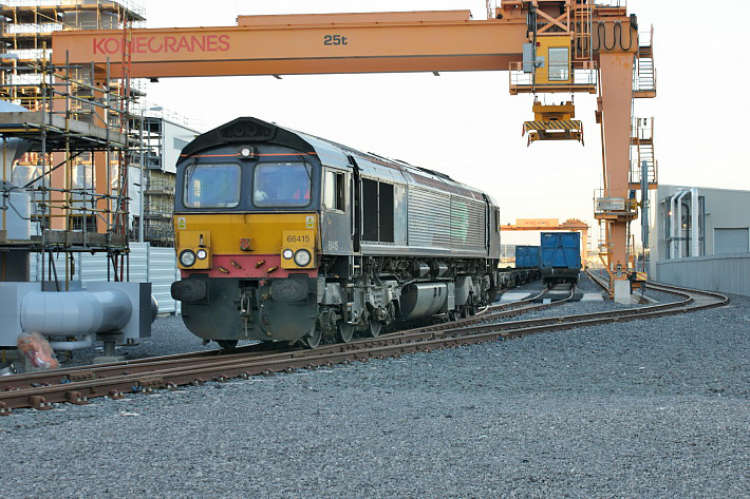
8D ASSOCIATION
The 8D Association is dedicated to promoting the history of the railways of South Lancashire, Merseyside and North Cheshire.
Ditton Junction to Weaver Junction. LNWR.

Introduction
The ever expanding railway system in the North West was becoming more congested by the mid 1840’s especially the route from Liverpool Lime Street to London Euston. At this time the journey involved using the Liverpool to Manchester line recently absorbed by the London and North Western Railway the LNWR as far as Earlestown then taking the ex Grand Junction Railway the GJR branch to Warrington to cross the River Mersey and head south towards Crewe. A solution to this had been proposed by the GJR in 1846 with a new line from Weaver to Ditton. This was never built, but it was the LNWR who after absorbing the GJR did construct the new line along with a new bridge across the River Mersey between Widnes and Runcorn.

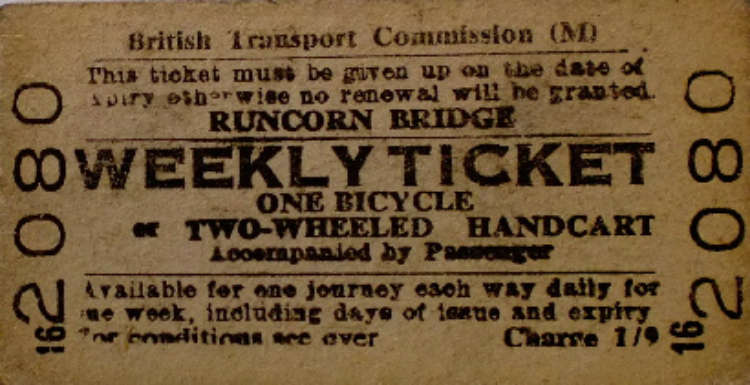

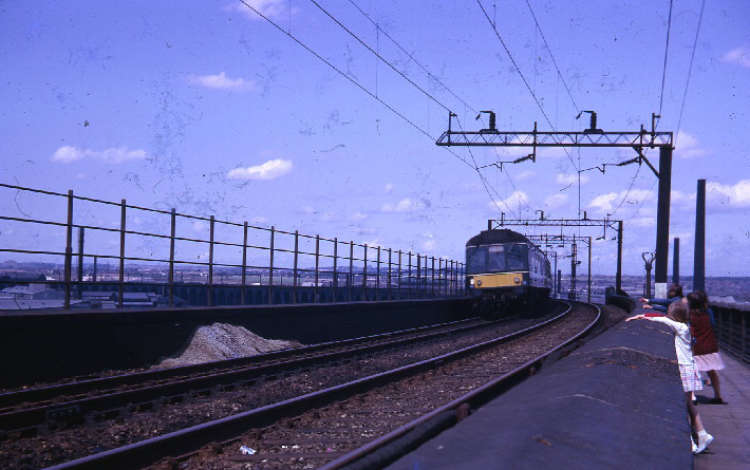
Work on the new bridge and its associated viaducts started in 1863 with a ceremony commemorating the laying of the ‘first’ stone in 1864. Works continued and by 1868 a huge new bridge across the Mersey was complete. The bridge would be named the Ethelfleda Bridge after the Queen of the Mercians who had visited Runcorn. The bridge was also decorated with the LNWR crest, an image of a Liver Bird and the City of London crest, which contains an image of Britannia, this is where the bridge gets its other name of the Britannia Bridge from. The viaducts connecting the bridge are also worthy of mention. There are three individual viaducts, from Ditton the first is of 49 arches then a short embankment with a further 16 arches before the bridge and then a further 33 arch viaduct on the Runcorn side. An estimated 17 million brick were used in the construction, which is still impressive today. The bridge itself is formed of 3 wrought iron spans of 305ft which sit on 2 sandstone abutments which have their foundations 45ft below water level. A footpath was also provided for people to walk across the bridge costing 1d. At the time the bridge was the longest in the world.
More detailed information and pictures (including the construction) here
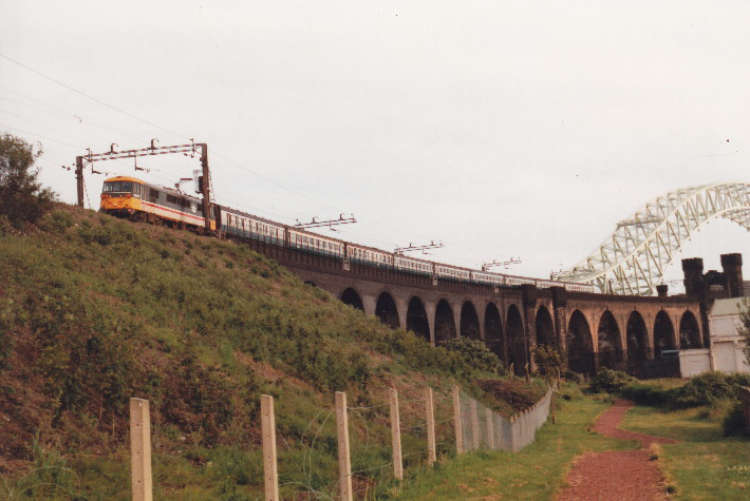
86417 crosses the second 16 arch viaduct section after travelling over the Ethelfleda Bridge the castellated entrance can be seen towards the rear of the train. The Silver Jubilee bridge which now dominates the skyline can be seen in the background. June 1987.
Operation and Stations.
The line opened for goods on the 1st February 1869 and for passenger traffic on the 1st April 1869. On the day of opening stations were also opened at Runcorn and Sutton Weaver. The station at Ditton Junction was not opened until 1st May 1871, though it would be the largest on the line with six platform faces.
The station at Sutton Weaver was an early casualty being closed to passengers on the 30th November 1931 and to goods on the 30th April 1942. Now no trace of the station remains only the station masters house stands as a reminder that there once was a station there.
For more information and pictures click here
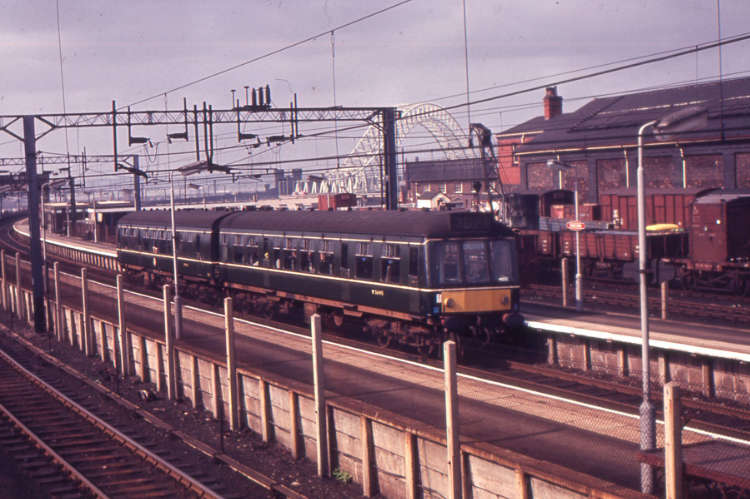
The station at Runcorn has thrived throughout the years and has been the principal calling point for express trains to London for many years now. Today it is operated by Virgin Trains and is as busy as ever with ample parking and bus links.


The third and largest station on the line, Ditton Junction was re-built in conjunction with the Liverpool to Crewe electrification project in the 1960’s when it was slightly reduced in size from six platform faces to five. Even though the area around it was not heavily populated the station was seen as an interchange where passengers could change to other services like the stopping trains toward Manchester. Within a couple of years of the major re-building the services to Manchester via Timperley were withdrawn and all intermediate stations closed, the slow decline of Ditton Junction had started. In the mid 1970’s the London Euston trains were withdrawn from Ditton but the station still hosted charter trains to London for school children. By the late 1980’s the Chester (summer only) service ceased to stop, the charter trains also ended and many of the local stopping trains had also ceased to call there, this was apart from two services each way in the morning and evening peak. The station did gain notoriety though becoming the first station to be closed by the privatised company Railtrack on the 27th May 1994. The station has since been demolished and Ditton No1 and Ditton No2 boxes both replaced by a new power box adjacent to the old station. There was also a timber yard adjacent to the station which had generated traffic flows with the supply of wooden sleepers. This has also closed and been demolished.
For more information and pictures click here
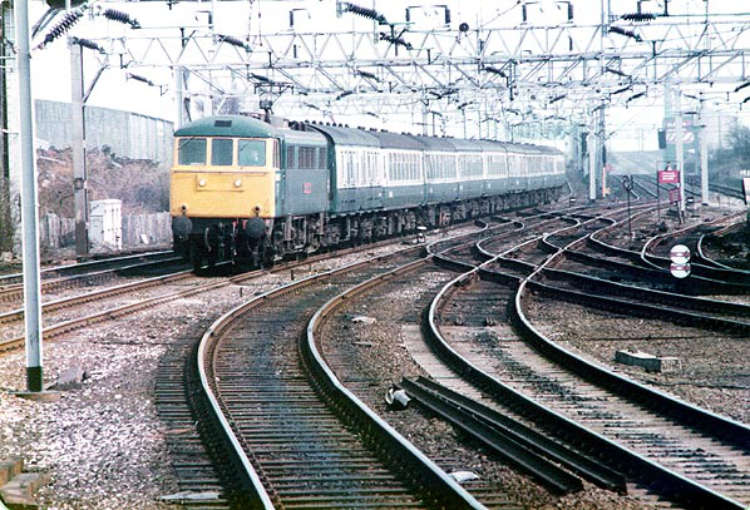
Today.
The 8 ½ mile line is still very busy today with a mixture of Virgin Pendolino expresses and London Midland stopping services. There is also a Summer Saturday only parliamentary service from Chester to Runcorn via the Halton curve, there is no return working as the junction from Runcorn to gain the Halton curve has been removed; although plans and funding is now in place for their reinstatement with a new Liverpool to Llandudno service being mooted. Freight flows are still numerous along the line with Freightliner container traffic to the port of Garston, new Range Rovers from the plant at Halewood, Stobart Ports now operate a container base on the site of the ex BOC plant and Ditton Foundry sidings have been brought back into use for a thrice weekly (Mon, Wed & Fri) service to and from Nievenheim, Germany to covey aluminium blocks. The Folly Lane branch at Runcorn has also seen a sharp up-turn in flows with the building of a power station on part of the former ICI Weston Workshops site. Freightliner operate several trains a day from the Manchester area conveying pelletised household waste to use as fuel.
For more information and pictures click here
